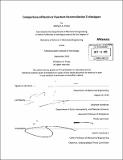Comparison of receiver function deconvolution techniques
Author(s)
Pesce, Kathryn A
DownloadFull printable version (8.987Mb)
Other Contributors
Massachusetts Institute of Technology. Dept. of Mechanical Engineering.
Advisor
Stéphane Rondenay.
Terms of use
Metadata
Show full item recordAbstract
Receiver function (RF) techniques are commonly used by geophysicists to image discontinuities and estimate layer thicknesses within the crust and upper mantle. A receiver function is a time-series record of the P-to-S (Ps) teleseismic wave conversions within the earth and can be viewed as the Earth's impulse response. An RF is extracted from seismic data by deconvolving the observed trace from an estimate of the source wavelet. Due to the presence of noise in the data, the deconvolution is unstable and must be regularized. Six deconvolution techniques are evaluated and compared based on their performance with synthetic data sets. These methods approach the deconvolution problem from either the frequency or time domain; some approaches are based on iterative least-squares inversions, while others perform a direct inverse of the problem. The methods also vary in their underlying assumptions concerning the noise distribution of the data set, level of automation, and the degree of objectivity used in deriving or choosing the regularization parameter. The results from this study provide insight into the situations for which each deconvolution method is most reliable and appropriate.
Description
Thesis (S.B.)--Massachusetts Institute of Technology, Dept. of Mechanical Engineering, September 2010. "September 2010." Cataloged from PDF version of thesis. Includes bibliographical references (p. 33-34).
Date issued
2010Department
Massachusetts Institute of Technology. Department of Mechanical EngineeringPublisher
Massachusetts Institute of Technology
Keywords
Mechanical Engineering.